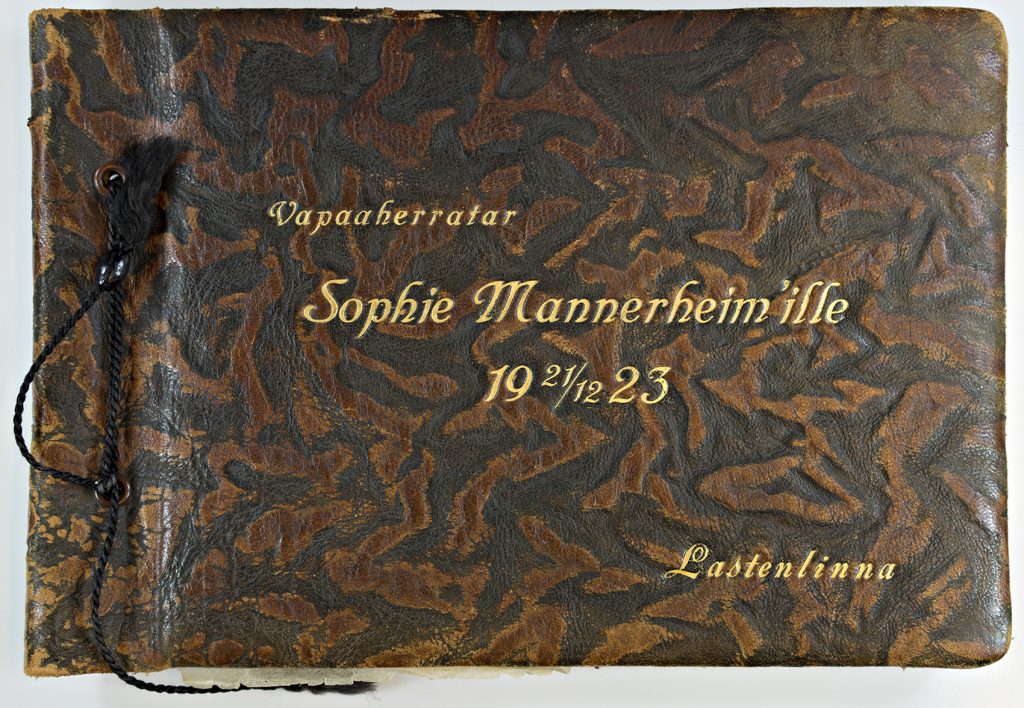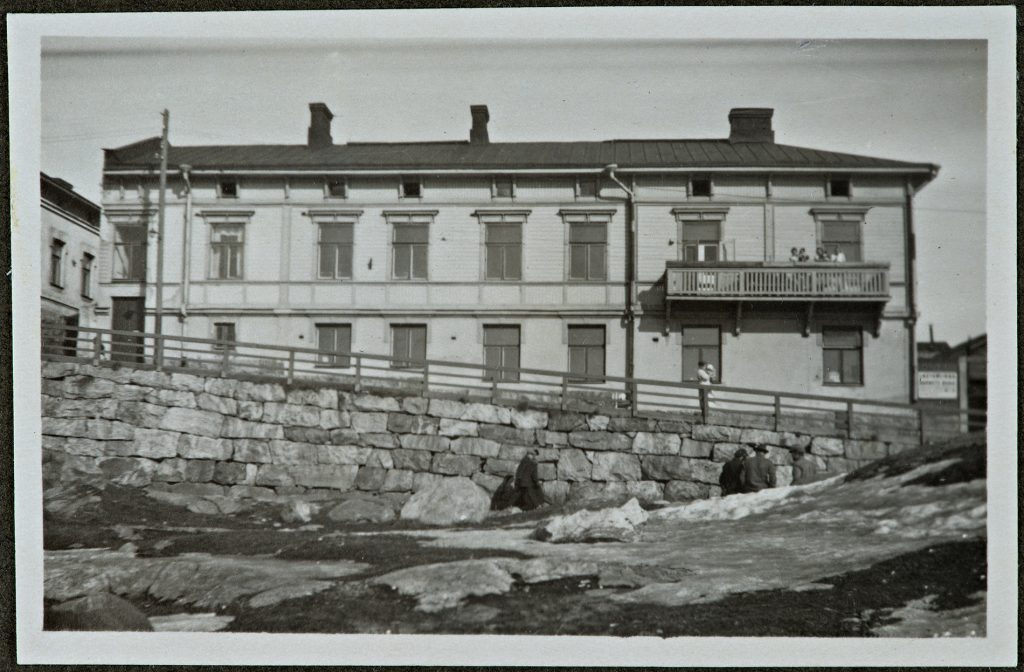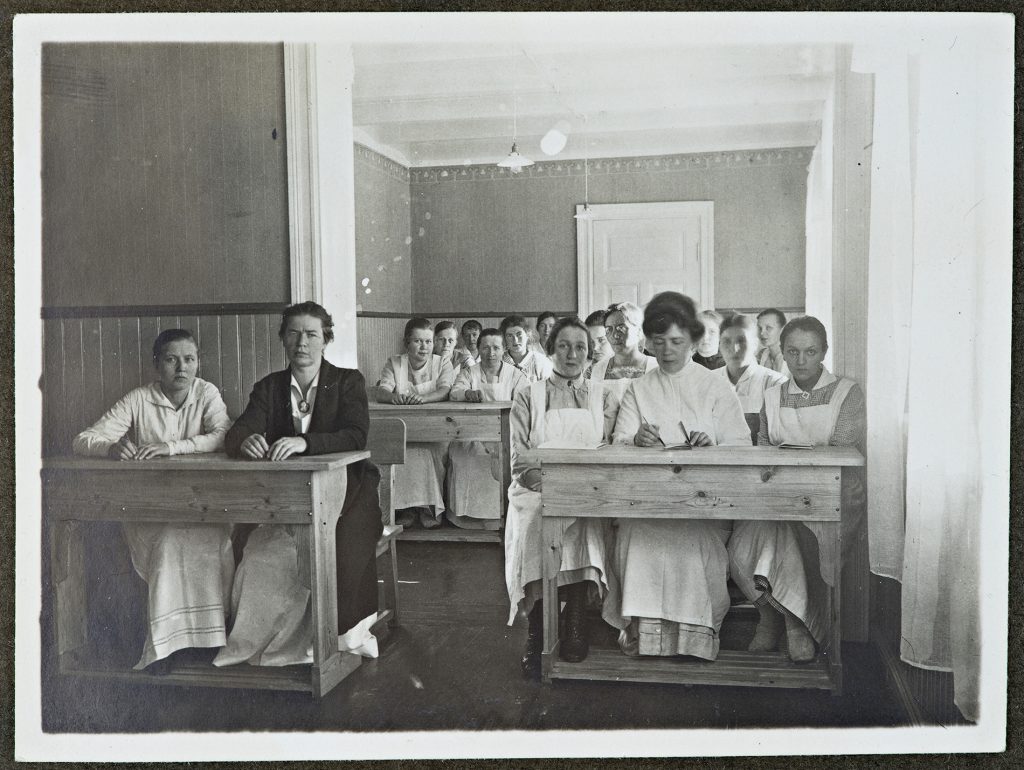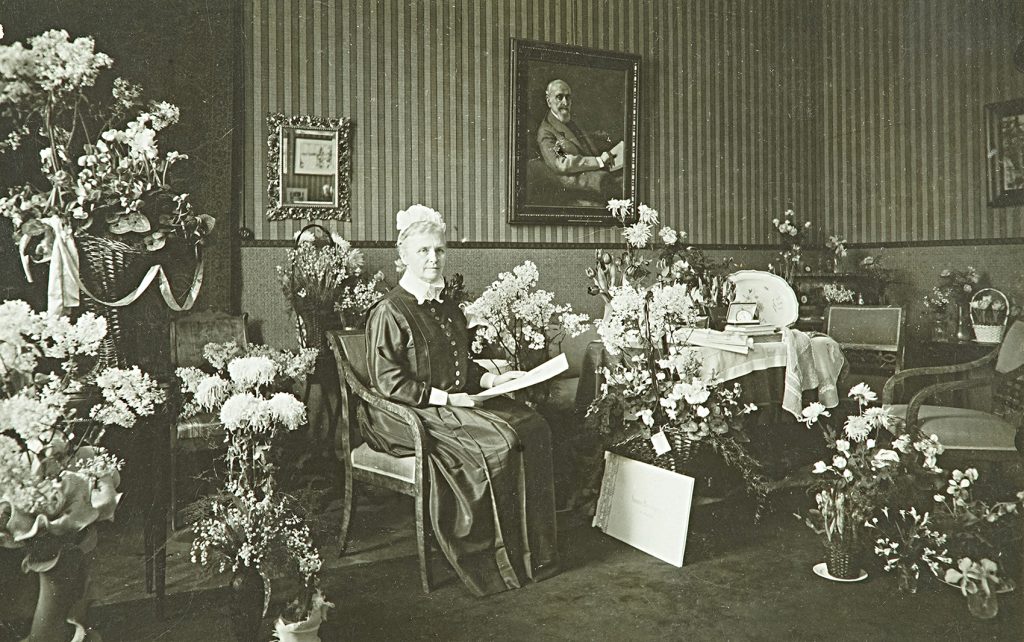“A love of flowers and children was one of Sophie Mannerheim’s defining features,” writes Tyyni Tuulio in a biography of Mannerheim. Upon her 60th birthday, Mannerheim received a photo album as a gift from the Children’s Castle hospital she had established. Enclosed within the album’s brown leather covers are 26 black-and-white photos of the old Children’s Castle and its patients and staff. This photo album is our object of the month.

Helping disadvantaged children
In the late 1910s, most Finnish children lived in dire circumstances in a country that was poor and lacked all basic necessities. The First World War and the Finnish Civil War of 1918, which tore the population apart, made the situation even more difficult. Many impoverished families lived in dark and dirty homes, with children left to fend for themselves as their parents tried to find jobs and make a living. Sophie Mannerheim was a nurse who dedicated herself to helping these children. She applied for a loan from a bank and used the funds to buy a wooden building at Toinen Linja 19 in the Kallio district of Helsinki to serve as a shelter for single mothers and their children. The building was named Lastenlinna, the Children’s Castle.

Many Finnish organisations for children that continue to work today were originally established in the 1920s. These include the Mannerheim League for Child Welfare (1920) and Save the Children Finland (1922). The involvement in the former of Sophie’s brother, General Carl Gustaf Emil Mannerheim, who had served as a military leader in the Civil War of 1918, did not make the league popular with everyone, but it did give the organisation a high profile. The Children’s Castle was brought under the Mannerheim League for Child Welfare and transformed from a shelter into a children’s hospital in 1921. In 1923 the Children’s Castle already operated daycare centres known as crèches and the country’s first maternity clinic, and organised courses in childcare. The nation’s wounds also began to heal as people witnessed the benefits of the league’s operations in Helsinki and, with their expansion, elsewhere in Finland, and the welfare of children and families improved.

The photos in Mannerheim’s album show the new and expanded operations of the Children’s Castle. The scenes depict adorable children in daycare, mothers with their children waiting their turn at the maternity clinic, and young women studying to become nursery care workers.

In addition to her hard work in the Mannerheim League for Child Welfare, Sophie Mannerheim was a loving guardian to three former child patients whom she took on as foster children: Mimmi Davidsson, Väinö Villgren and Arne Ahlgren. The story of Villgren, who was unable to move because of paralysis, inspired Mannerheim to write his biography, which was published after his death in 1926.
From aristocrat to head nurse
Eva Charlotta Lovisa Sophie Mannerheim, the eldest child of Hélène von Julin and Count Carl Robert Mannerheim, was born on 21 December 1863 at Louhisaari (Villnäs) Manor in southwestern Finland. In the following years, her parents had six more children, of whom Gustaf, later Marshal Mannerheim and still later President of Finland, has been described as her closest sibling. It has been said that Sophie inherited her sense of public duty from her mother, Countess Hélène, who took good care of her tenants and their children. However, Sophie’s privileged and carefree childhood came to a bleak end when her father was declared bankrupt and escaped to Paris with his mistress. Sophie’s mother died with a broken heart, Louhisaari Manor was sold, and the siblings were dispersed in different directions.
Sophie Mannerheim made a living as a governess, a bank employee and a clerk until 1896 when she married Hjalmar Linder, one of Finland’s wealthiest businessmen and a manor owner. However, the marriage was dissolved just a few years later. The couple had no children, and the idle life of a lady of the manor failed to satisfied Mannerheim. “With private happiness and a family having proved impossible, Sophie dedicated herself to serving humanity,” writes Veijo Meri in a biography of her brother Gustaf. Mannerheim travelled to London to study nursing. Her three-year training at the Nightingale Training School for Nurses, named after Florence Nightingale, and at St Thomas Hospital provided her with excellent professional qualifications. Soon after returning to Finland, Mannerheim was appointed head nurse of the Surgical Hospital.
The position of head nurse meant Mannerheim played a key role among Finnish nurses in the early decades of the 1900s. Her job description included not only hospital work, but also the training of new professionals in the hospital’s nursing courses. Under her leadership, the training was extended and diversified. Mannerheim was a capable head nurse who over the years pushed through several reforms in the field, served on various committees and held elected positions in organisations in Finland and abroad. Thanks to her tireless efforts, up-to-date nursing expertise based on advanced training and the incorporation of practice and theory gained a foothold in Finland. Mannerheim was also elected as chair of Suomen Sairaanhoitajayhdistys (the Finnish Nurses’ Association).

Until her death, Mannerheim remained a highly regarded role model for Finnish nurses. However, her last years were overshadowed by language disputes between Finnish- and Swedish-speaking factions that emerged in Finland in the mid-1920s not just among nurses, but within the population as a whole. Mannerheim’s physical health deteriorated after she broke a spinal bone in a car accident in the autumn of 1925 in Sweden. She never fully recovered, suffering from ill health in her last few years. She passed away on 9 January 1928 at the age of 64 in her residence at the Surgical Hospital. Luckily, however, the Children’s Castle did not die with its founder, but continued to grow. To this day, both the Mannerheim League for Child Welfare and the New Children’s Hospital carry on the work of Sophie Mannerheim.
Katariina Pehkonen, Curator
Translation: University of Helsinki Language Services.
Sources:
Aalto, Maija: Suomen rakastetuin keksintö täyttää sata vuotta: https://www.hs.fi/kaupunki/art-2000008855036.html. Accessed 26 October 2022.
‘Baby in the Box’ online exhibition: https://tarinasoitin.fi/bib. Accessed 26 October 2022.
Epäilys, Heidi & Hannu, Aura (2015): Sophie Mannerheim – Henkilökuva ja elämäntyö suomalaisen sairaanhoidon kehittäjänä. Metropolia Ammattikorkeakoulu.
Forsius, Arno: Sophie Mannerheim, suomalaisen sairaanhoidon uranuurtaja: http://www.saunalahti.fi/arnoldus/smannerh.html. Accessed 26 October 2022.
Iltalehti 9 September 1925.
Meri, Veijo (1993): C.G. Mannerheim, Suomen marsalkka.
Tallberg, Marianne (1997): Mannerheim, Sophie. Website of the National Biography of Finland. Studia Biographica 4. Helsinki: Finnish Literature Society. http://urn.fi/urn:nbn:fi:sks-kbg-003546, accessed 11 November 2022.
Tuulio, Tyyni (1948): Vapaaherratar Sophie Mannerheim: ihminen ja elämäntyö. WSOY.
Varmavuori, Marjaana: Sophie Mannerheim käveli Kalliossa ja järkyttyi: https://www.hs.fi/kaupunki/helsinki/art-2000006380719.html. Accessed 26 October 2022.
